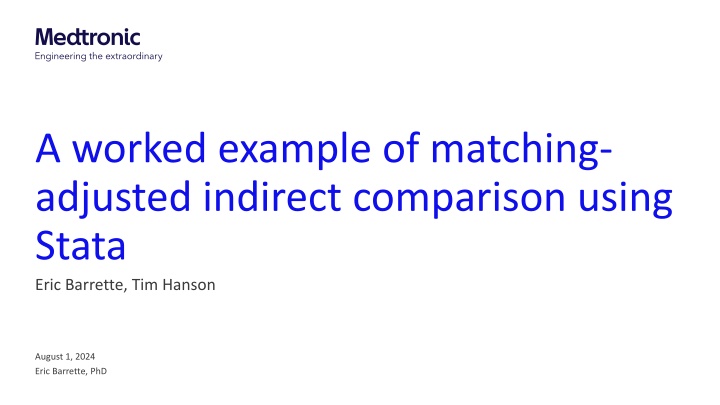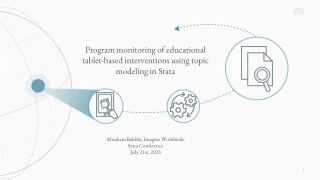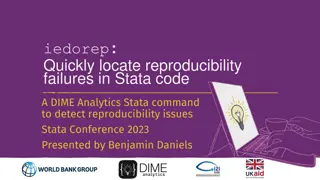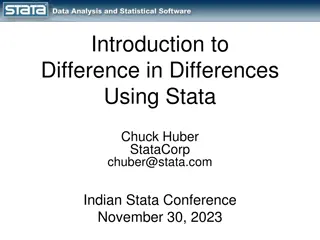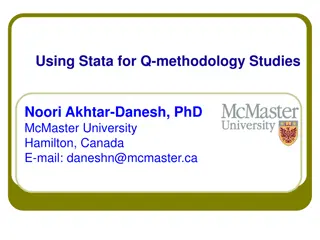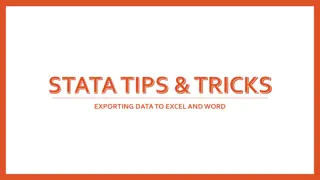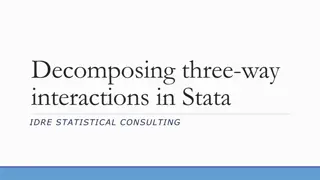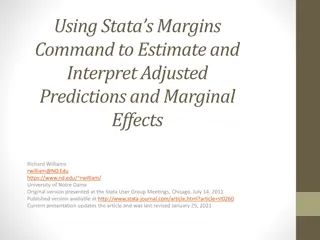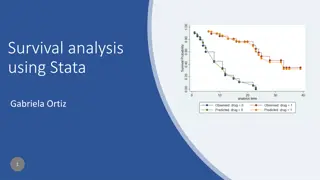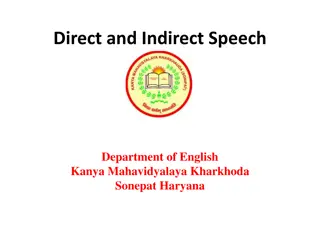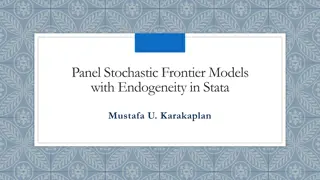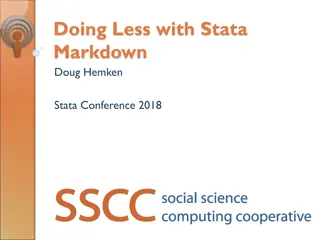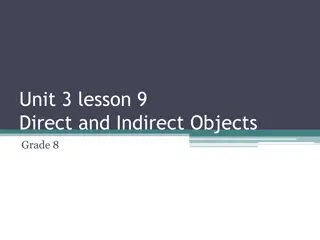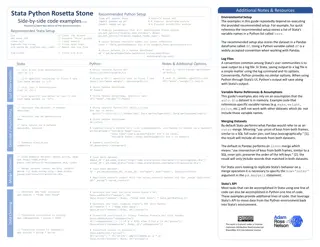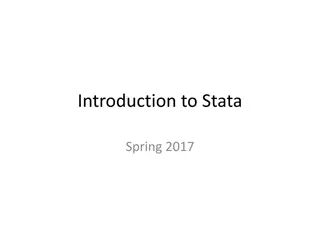Matching-Adjusted Indirect Comparison Using Stata
Industry and regulatory interest in comparing treatments not directly compared in trials. Method of indirect comparison using aggregate data. Use of individual patient data if available. Introduction to Matched Adjusted Indirect Comparison method. Overview of methods for treatment arms B and C, including logistic propensity score model estimation. Applications in drug development plans and regulatory submissions. Guidance for Stata users on performing MAIC analyses in health economics and outcomes research.
Download Presentation

Please find below an Image/Link to download the presentation.
The content on the website is provided AS IS for your information and personal use only. It may not be sold, licensed, or shared on other websites without obtaining consent from the author.If you encounter any issues during the download, it is possible that the publisher has removed the file from their server.
You are allowed to download the files provided on this website for personal or commercial use, subject to the condition that they are used lawfully. All files are the property of their respective owners.
The content on the website is provided AS IS for your information and personal use only. It may not be sold, licensed, or shared on other websites without obtaining consent from the author.
E N D
Presentation Transcript
A worked example of matching- adjusted indirect comparison using Stata Eric Barrette, Tim Hanson August 1, 2024 Eric Barrette, PhD
Background Motivation Industry, regulators, and payers have growing interest in comparing treatments that have not been directly compared in trials (e.g., trials of drugs B vs A and C vs A but B vs C) Method of indirect comparison using aggregate data and results from both trials are available (Bucher et al. 1997) Related to approaches used in network meta-analysis What if individual patient data (IPD) was available? Likely IPD is available for one of the treatments - unlikely IPD is available for both If IPD is available for both trials other observational methods can be applied Matched Adjusted Indirect Comparison (Signorovitch et al. 2010) uses available IPD Re-weight IPD so average (and higher moment) characteristics match the aggregate characteristics of other treatment and then compare outcomes between balanced populations Intuition: Assume re-weighting patients in the trial with IPD by their odds of having been enrolled in the trial without IPD Numerous assessments, advances, applications, have been published since 2 Stata MAIC example | August 1, 2024 | Stata Conference 2024
Background Methods overview Consider treatment arms B and C: the effect of B vs C on an outcome as a function of weights that are the odds that patient i receives treatment t = C versus t = B (i.e. enrolls in trial 1 vs trial 0) given baseline characteristics Estimate a logistic propensity score model (include effect modifiers but not prognostic variables), which is equivalent to: log ??? = ?0 + ?1 ??? But without IPD for both treatments the traditional MLE approach can t be used Use a method of moments estimate for , and calculate weights using ? ?? Estimate ?by minimizing: ?,?exp(?1 ??? Center X s with aggregate data ??) when ??? ??= 0 Matching-adjusted treatment effect adjusts the patient population observed to receive treatment T=0 by re-weighting each individual patient by the estimated odds of receiving treatment T=1 vs T= 0. Placebo-arm data is incorporated by applying adjusted indirect comparisons after baseline characteristics are balanced across trials 3 Stata MAIC example | August 1, 2024 | Stata Conference 2024
Background Applications Indirect comparisons are a key component of drug development plans and support defining product value because they enable therapies used in clinical practice and new therapies to be compared indirectly when there is a lack of head-to-head randomized controlled trials Acceptance by regulatory and HTA bodies varies but inclusion of MAIC in submissions is increasing A 2019 search of NICE website found 21 appraisals including MAIC between 2014 2019 17 from 2017 or later Source: https://ispor.confex.com/ispor/euro2019/meetingapp.cgi/Paper/97251 Review of CADTH technology assessments found 22 MAIC analyses between 2016 and 2022 Source: https://www.valueinhealthjournal.com/article/S1098-3015%2821%2902789-3/fulltext As a Stata user, how can I perform MAIC analyses? Likely to come up in my role in Health Economics and Outcomes Research for HTA submissions and possibly other types of regulatory submissions Need to be able QC other work can review code and parallel code 4 Stata MAIC example | August 1, 2024 | Stata Conference 2024
MAIC in statistical software Example SAS code (2011): Source: https://support.sas.com/resources/papers/proceedings11/228-2011.pdf Worked example in R (2016): Source: https://research-information.bris.ac.uk/ws/portalfiles/portal/94868465/Appendix_D_Worked_example_of_MAIC_and_STC.pdf Where is the Stata package? (2020) (2022) Source: https://www.statalist.org/forums/forum/general-stata-discussion/general/1544952-stata-packages-for-population-adjusted-indirect-comparisons-maic-and-stc 5 Stata MAIC example | August 1, 2024 | Stata Conference 2024
Worked example Data Simulate data for two trials A vs B and A vs C: 2 variables: age and gender - age is an effect modifier and gender a prognostic variable The AB trial (N(AB) = 500): ages 45 to 75, 64% females The AC trial (N(AC) = 300): ages 45 to 55, 80% females Data for the AC trial is aggregated (as if it were reported in a publication) The MAIC uses IPD of AB trial and aggregate AC data to compare B to C Mean (SD) age = 49.80667 (3.082363) Generate simulated data from Phillippo et al. (2016) using R code provided in appendix R code includes the seed value allowing for exact replication of data for a direct test of Stata vs R Can simulated data with the same parameters in Stata but not the exact same data Source: Phillippo, D.M., Ades, A.E., Dias, S., Palmer, S., Abrams, K.R., Welton, N.J. NICE DSU Technical Support Document 18: Methods for population-adjusted indirect comparisons in submission to NICE. Appendix D. 2016. Available from http://www.nicedsu.org.uk 6 Stata MAIC example | August 1, 2024 | Stata Conference 2024
Solving the optimization problem using MATA objfn <- function(a1, X){ } sum(exp(X %*% a1)) gradfn <- function(a1, X){ } colSums(sweep(X, 1, exp(X %*% a1), "*")) X.EM.0 <- sweep(with(AB.IPD, cbind(age, age^2)), 2, with(AC.AgD, c(age.mean, age.mean^2 + age.sd^2)), '- ) print(opt1 <- optim(par = c(0,0), fn = objfn, gr = gradfn, X = X.EM.0, method = "BFGS")) a1 <- opt1$par wt <- exp(X.EM.0 %*% a1) wt.rs <- (wt / sum(wt)) * N_AB # rescaled weight sum(wt)^2/sum(wt^2) AB.IPD %>% mutate(wt) %>% summarise(age.mean = weighted.mean(age, wt), age.sd = sqrt(sum(wt / sum(wt) * (age - age.mean)^2)) ) AC.AgD[, c("age.mean", "age.sd")] Source: Phillippo, D.M., Ades, A.E., Dias, S., Palmer, S., Abrams, K.R., Welton, N.J. NICE DSU Technical Support Document 18: Methods for population-adjusted indirect comparisons in submission to NICE. Appendix D. 2016. Available from http://www.nicedsu.org.uk 7 Stata MAIC example | August 1, 2024 | Stata Conference 2024
Comparing R and Stata results Outputs Stata R 2) 1. Parameter estimates 1) 2) 2. Objective function value at minimum 1) 3a) 3b) 3c) 3a) 3. Distribution of rescaled weights 3b) 3c) 4) 4. Adjusted sample size 4) 5. Weighed population summary stats 5) 5) Source: Phillippo, D.M., Ades, A.E., Dias, S., Palmer, S., Abrams, K.R., Welton, N.J. NICE DSU Technical Support Document 18: Methods for population-adjusted indirect comparisons in submission to NICE. Appendix D. 2016. Available from http://www.nicedsu.org.uk 8 Stata MAIC example | August 1, 2024 | Stata Conference 2024
An aside Balancing population characteristics sounds like entropy balancing? 1. Yes. In fact, entropy balancing is another approach that yields same weights: Phillippo DM, Dias S, Ades AE, Welton NJ. Equivalence of entropy balancing and the method of moments for matching-adjusted indirect comparison. Res Synth Methods. 2020 Jul;11(4):568-572. 2. Stata has entropy balancing (ebalfit or ebalance) commands, and they can be adapted to MAIC: Use centered population characteristics as targets 9 Stata MAIC example | August 1, 2024 | Stata Conference 2024
Indirect comparison: the relative effect of B vs A and B vs C in the AC population R example Source: Phillippo, D.M., Ades, A.E., Dias, S., Palmer, S., Abrams, K.R., Welton, N.J. NICE DSU Technical Support Document 18: Methods for population-adjusted indirect comparisons in submission to NICE. Appendix D. 2016. Available from http://www.nicedsu.org.uk 10 Stata MAIC example | August 1, 2024 | Stata Conference 2024
Indirect comparison: the relative effect of B vs A and B vs C in the AC population Stata version 11 Stata MAIC example | August 1, 2024 | Stata Conference 2024
Another Aside: simulated treatment comparison worked example An alternative approach to MAIC Source: Phillippo, D.M., Ades, A.E., Dias, S., Palmer, S., Abrams, K.R., Welton, N.J. NICE DSU Technical Support Document 18: Methods for population-adjusted indirect comparisons in submission to NICE. Appendix D. 2016. Available from http://www.nicedsu.org.uk 12 Stata MAIC example | August 1, 2024 | Stata Conference 2024
Comparison of indirect effect estimates Indirect comparison estimates (95% CIs) by method and software R Stata -3.215 -3.215 B vs A: MAIC (-4.006, -2.424) (-3.997, -2.433) -3.000 -3.000 B vs A: STC (-3.687, -2.312) (-3.687, -2.312) -0.032 -0.032 B vs C: MAIC (-1.043, 0.980) (-1.037, 0.973) B vs C: STC -0.247 -0.247 (-1.180, 0.686) (-1.180, 0.686) Note: the true effect size of B vs A is -2.885 and the true effect size of C vs B is -0.400 Source: Phillippo, D.M., Ades, A.E., Dias, S., Palmer, S., Abrams, K.R., Welton, N.J. NICE DSU Technical Support Document 18: Methods for population-adjusted indirect comparisons in submission to NICE. Appendix D. 2016. Available from http://www.nicedsu.org.uk 13 Stata MAIC example | August 1, 2024 | Stata Conference 2024
An application of MAIC Using MATA approach in practice 14 Stata MAIC example | August 1, 2024 | Stata Conference 2024
Where is the MAIC Stata command? Do we need one? Stata has the functionality to estimate the parameters needed for MAIC calculations in multiple ways with commands/packages that already exist (e.g., MATA, ebalfit, ebalance) An MAIC specific command could help with the arithmetic of calculating weights and the indirect comparison of hazard ratios, odds ratios, etc. which was tedious and potentially error prone Maybe a Stata command will be available soon? From a 2023 Northern European Stata Conference presentation: Source: https://www.stata.com/meeting/northern-european23/slides/Northern_Europe23_Crowther.pdf 15 Stata MAIC example | August 1, 2024 | Stata Conference 2024
Thank you Eric Barrette, PhD Senior Director, Health Economics and Outcomes Research Medtronic eric.barrette@medtronic.com
